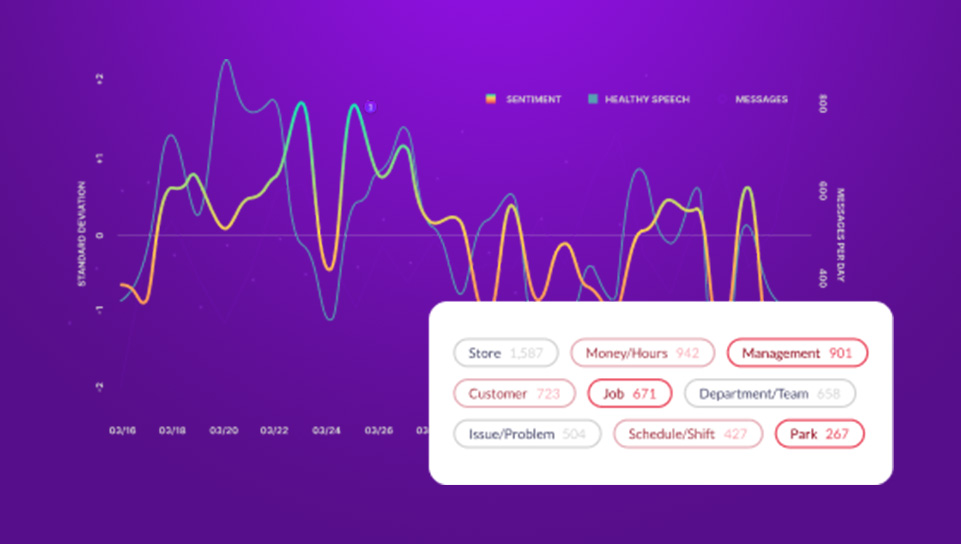What a Toxic Employee Can Cost Your Company
by Aware
Rarely a day goes by without a headline that reveals misconduct or poor culture at a major enterprise organization. Depending on the offense, the impact of toxic employee behavior varies widely, but regardless the potential damage is significant.
The Damage of a Toxic Employee at Work
- Lower Morale. In a Harvard Business Review study, 25% of employees say they dread going to work because of toxicity (Society for Human Resources Management 2019 Literature Review)
- Performance Decline. With the contagious nature of toxicity, 38% of workers intentionally decrease work quality in toxic environments (Harvard Business Review)
- Higher Turnover. Gartner found that 12% of employees have left an organization entirely due to a toxic coworker.
- Increased Risk. Overlooked toxic behaviors, such as bullying or harassment, can open a company up to legal risk. Unfortunately, companies like Amazon, NBC, or Tesla know all too well the repercussions of turning a blind eye to toxic behavior.
- Damaged Brand Reputation. If a situation escalates to legal action or becomes a press nightmare, organizations face both financial and organizational costs to deal with litigation, public relations, crisis management and brand reputation management.
In the summer of 2020, “The Ellen DeGeneres Show” was rocked by accusations from a dozen different employees of a top-down toxic culture. Despite a public apology and the dismissal of two executive producers, ratings faltered, advertisers jumped ship, and in May 2021, Ellen announced the upcoming nineteenth season would be the show’s last.
In October 2021, a San Francisco court awarded a former Tesla employee $137 million in damages finding that Tesla was fostering a hostile workplace. Following this ruling a class action suit launched against the company alleged a widespread culture of discrimination and harassment, dramatically highlighting the financial burden of failing to address toxic work environments.
Artificial Intelligence and Toxic Behaviors
The cost of a wounded culture cannot be understated, leading to increased turnover, reduced productivity, and decreased brand sentiment. Protect your organization, and its culture, by investing the time and resources to minimize and remove toxic scenarios.
Identify and Address Toxic Behaviors in the Workplace
Firing a toxic employee can prove difficult due to the lack of “hard evidence” exposing the behavior, yet these employees hurt the business. As employee communications continues to become more digital, that "hard evidence" is also easier to discover.
At Aware, we analyzed the contents of over 1,000,000 employee messages and found—among other insights—that communications in one-to-one conversations are 250% more likely be to toxic than a public message.
Learn more about what we found in our Human Behavior Risk Analysis Report.
By leveraging artificial intelligence, human resources teams can revolutionize the way they identify and deal with toxic employees.
For example, company leaders can monitor employee digital communications—such as private or public messages in Microsoft Teams or Workplace by Meta —and automatically flag violations of predetermined company policies.
This saves teams a significant amount of effort searching for evidence of a violation and creates more time to determine an appropriate response.
Determine an Action Plan
In a digital scenario, some tools, such as Aware, allow automation when violations or other incidents occur.
For example, organizations can set messages with a high level of sexual content to notify a human resources representative for follow up.
Alternatively, content with foul speech can trigger an automated communication coaching the employee that the transmitted word choice is inappropriate for work. Each organization is unique, and therefore must determine the most appropriate response based on existing corporate culture. Most importantly, though, leaders must consistently communicate that the organization will not tolerate toxic behavior.
The Industry Leading Enterprise Collaboration Monitoring & Insights Solution
Aware's AI-driven, proprietary sentiment model analyzes workplace communication and delivers a real-time sentiment metric informed by both message content and context.
Leaders need only to check a dashboard to keep a pulse on organization sentiment. If they see an issue, they can investigate—bias free. With shared content monitoring functionality, the team can also pull relevant messages and leverage additional context to identify the root of the sentiment change.
Discover potential blind spots in your organization.
Download the Human Behavior Risk Analysis Report to better understand employee behavior that could be threatening your organization's security, compliance and culture.








